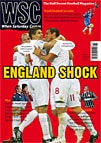 The digits on the back of footballers' shirts seem to be getting higher and higher. Seb Patrick examines a recent trend
The digits on the back of footballers' shirts seem to be getting higher and higher. Seb Patrick examines a recent trend
Australia’s Asian Cup qualifier against Kuwait in March of this year drew attention for a number of reasons – namely that the side was made up entirely of A-League players and that it slumped to a shock 1-0 defeat. To the eye of someone with an interest in shirt numbers, however, the game was notable in an entirely different way – as starting winger Daniel Mullen and substitutes Fabian Barbiero and Mitch Nichols took to the field sporting three-digit numbers on their backs.
Due to the non-participation of their usual Europe-based players, the Socceroos were naming an entirely fresh 22-man squad in a qualifying tournament that required fixed shirt numbers for its duration, so the use of higher than usual figures was inevitable – but in giving players carte blanche to choose numbers like 107, 109 and 111, the Australians marked another turning point in the evolution of the very meaning and purpose of squad numbers.
Like anything else in football, it all used to be so much more simple. When squad numbers were solely used in international tournaments there was no call to number above the 22 featured in the squad, and these were usually distributed in sensible fashion – although exceptions include Argentina’s brief flirtation with alphabetical numbering (which led to Ossie Ardiles wearing 1 in the 1982 World Cup) and the random assignment of Brazil in 1958 that somehow still gave Pelé the famous number 10.
But the introduction of fixed numbers to club football, where players would routinely move about between squads of up to 30 or more, changed the landscape. For the first time, individual significance was given to numbers above the standard 1 to 11 – Roy Keane’s 16, John Terry’s 26 and Thierry Henry’s 14 just some of the digits idiosyncratically associated with a certain player by virtue of their becoming folk legends in that brief time between signing for the club and their preferred position’s traditional number becoming free.
Not that the “classic” numbers don’t still hold a certain cachet – starting the season registered as, say, 9 or 5 immediately sends out the message that you should be considered a first choice in your respective position. Plenty of these numbers remain cherished by their owners, with the stripping of a particular number often cause for dispute. Of late, the allocation of squad numbers seems to have revolved less around the prestige of a particular number and instead simply whether a given player likes the look of it.
There can be no other rational explanation for William Gallas’s choice of 10 at Arsenal, Milan Baros’s four-year hogging of 5 at Liverpool, or Chelsea giving the number 9 shirt to Khalid Boulahrouz and then Steve Sidwell. Manchester City, meanwhile, despite having around 16 strikers on their books, are currently without a registered 9.
Yet traditionally even the stranger choices would usually still have some pretence towards falling within the actual number of players in a squad. On the continent even this boundary has been gradually chipped away at.
While Portugal keeper Vítor Baía wore 99 for some years, a more ready source of blame can be found at serial offenders AC Milan. Apparently afraid of upsetting existing players by handing over their numbers to new signings (demonstrated by giving Ronaldo the number 99 shirt in 2007), they hit upon a new method of distribution in 2008, with Ronaldinho, Andriy Shevchenko and Luca Antonini sporting the years of their birth – 80, 76 and 82 respectively.
This flagrant disregard for anything remotely resembling the reality of a squad size is a trend that’s finally crossed to these shores courtesy of Nicklas Bendtner, who switched to 52 at the start of this season simply “because it’s a special number to me personally”. Lower league players have sported high numbers before – Ade Akinbiyi famously wore 55 for Crystal Palace with a little plus sign between the digits, so desperate was he to wear the unavailable 10 – but Bendtner is the first in the Premier League to take advantage of the lifting of an informal restriction on numbers above 50.
Artificially high squad numbers can serve a purpose, of course. In American football, sets of ten or 20 digits are allocated to specific positions and a two-digit number, by simple virtue of being more distinctive, offers greater opportunity for branding, most notably demonstrated by David Beckham’s much-heralded choice of 23 at Real Madrid and LA Galaxy. It’s also worth noting that, despite advance rumours to the contrary, Beckham elected against wearing 75 when on loan at Milan. But you suspect a line has to be drawn somewhere – no squad, whether international or club, would need to register over 100 players in a single season.
After all, fail to curb the current excesses and where might things lead? Perhaps a player's desire for a more distinctive combination could lead to the inclusion of letters – you can get 1,296 unique pairs of you add in A to Z, without even having to stretch to a third digit. Or maybe, one day, we'll see someone run out with IT on their back.
From WSC 273 November 2009